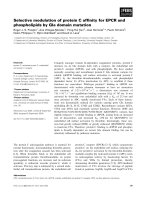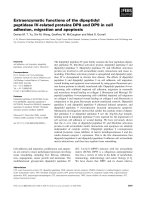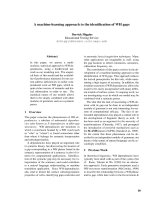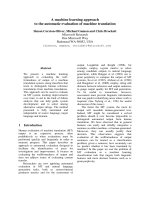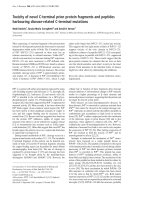Prediction of novel biochemical class disease related proteins and microRNAs by machine learning approach
Bạn đang xem bản rút gọn của tài liệu. Xem và tải ngay bản đầy đủ của tài liệu tại đây (2.54 MB, 173 trang )
PREDICTION OF NOVEL BIOCHEMICAL CLASS,
DISEASE RELATED PROTEINS AND MICRORNAS BY
MACHINE LEARNING APPROACH
ZHANG HAILEI
(B.Sc. & M.S., Dalian University of Technology)
A THESIS SUBMITTED
FOR THE DEGREE OF DOCTOR OF PHILOSOPHY
DEPARTMENT OF PHARMACY
NATIONAL UNIVERSITY OF SINGAPORE
2008
Prediction of novel biochemical class, disease related proteins and microRNAs by machine learning approach I
ACKNOWLEDGEMENTS
Foremost, I would like to present my sincere thanks to my supervisor, Professor Chen
Yu Zong, for his excellent guidance, invaluable advices throughout my PhD study.
I would like to thank Professor Cao Zhiwei and Professor Ji Zhiliang for their
insightful suggestions to my work on the prediction of disease related protein and
multifunctional enzymes.
My sincere gratitude also goes to BIDD group members, especially Dr. Lin
HongHuang, Dr. Han Lianyi, Dr. Zheng Chanjuan, Dr. Cui Juan, Dr. Wang Rong, Ms.
Tang Zhiqun, Mr. Xie Bin, Ms. Ma Xiaohua, Miss Jia Jia, Miss Liu Xin, Miss Shi
Zhe, Miss Wingyee, Mr. Zhu Feng, Mr. Liu Xianghui, Ms. Ong Serene etc. I am
really thankful for their valuable suggestions and support in my project, as well as
enjoy the close friendship among us.
Last, but not the least, I am eternally grateful to my parents and my husband for
supporting and encouraging me throughout my life.
Zhang Hailei
April 2008
Prediction of novel biochemical class, disease related proteins and microRNAs by machine learning approach II
TABLE OF CONTENTS
ACKNOWLEDGEMENTS I
TABLE OF CONTENTS II
SUMMARY IV
LIST OF TABLES VII
LIST OF FIGURES X
LIST OF ACRONYMS XIII
1. Introduction 1
1.1. Introduction to multifunctional enzymes (MFEs) 2
1.2. Introduction to disease related proteins 4
1.2.1. Antimicrobial proteins 4
1.2.2. Antibiotic resistance proteins 5
1.2.3. Cancer associated proteins 7
1.3. Introduction to microRNAs 9
1.4. Overview of computational methods for biological function prediction 12
1.4.1. Sequence similarity method 12
1.4.2. Motif based methods 13
1.4.3. Machine learning approach 15
1.5. Scope and objective 15
2. Methods 18
2.1. Machine learning methods 18
2.1.1. Support Vector Machine (SVM) 19
2.1.2. K-Nearest Neighbors (KNN) 27
2.1.3. Neural Networks (NN) 29
2.1.4. Decision Tree (DT) 30
2.2. Feature selection 32
2.3. Performance evaluation 34
2.4. Construction of feature vectors 35
2.4.1. Protein feature vectors 35
2.4.2. MiRNA feature vectors 39
3. In silico search and characterization of multifunctional enzymes 41
3.1. Selection of MFEs and non-MFEs 41
3.2. Evaluation and discussion 43
3.2.1. Structural preference of MFEs 43
3.2.2. Characteristics of MFEs from pathway and evolution perspective
………………………………………………………………… 45
3.2.3. Identification of novel MFEs 56
3.2.4. Contribution of physicochemical properties in the classification of
MFEs………………………………………………………………………57
3.3. Server for identification of multifunctional enzyme (SIME) 58
3.4. MFEs database 61
3.5. Summary 64
4. Prediction of disease related proteins by support vector machine 66
4.1. Prediction of antimicrobial proteins 66
4.1.1. Selection of antimicrobial proteins and non-antimicrobial
proteins …………………………… ………………………………… 66
4.1.2. Prediction performance for antimicrobial proteins 68
Prediction of novel biochemical class, disease related proteins and microRNAs by machine learning approach III
4.1.3. Prediction of novel antimicrobial proteins 69
4.1.4. Contribution of feature properties 76
4.1.5. Server for antimicrobial protein identification (SAPI) 76
4.2. Prediction of antibiotic resistance proteins 77
4.2.1. Selection of ARPs and non-ARPs 78
4.2.2. Prediction performance 79
4.2.3. Prediction of novel ARPs 80
4.2.4. Scanning bacteria genomes 81
4.2.5. Contribution of feature properties to the classification of ARPs.82
4.2.6. Server for antibiotic resistance protein identification (SARPI) 82
4.3. Prediction of cancer associated proteins 84
4.3.1. Data preparation 84
4.3.2. Overall prediction accuracies and performance evaluation 85
4.3.3. Contribution of feature properties to the classification of cancer
associated proteins 86
4.3.4. Analysis of individual feature contribution by feature selection .87
4.3.5. Cancer associated protein identification server (CAPIS) 88
4.4. Comparison with other statistical learning methods 90
4.5. Summary 91
5. Prediction of microRNAs by machine learning methods 93
5.1. Data preparation 93
5.1.1. Retrieval of precursor miRNAs and non-precursor miRNAs 93
5.1.2. Retrieval of mature miRNAs and non-mature miRNAs 94
5.2. Evaluation and discussion 95
5.2.1. Prediction performance for precursor miRNAs and mature
miRNAs… 95
5.2.2. Screening non-coding RNAs within four representative genomes
………………………………………………………………… 97
5.2.3. Comparison with other statistical learning methods 97
5.3. MiRNA prediction server 99
5.3.1. Comparison with other micoRNA prediction servers 99
5.4. Summary 104
6. Conclusion and future work 105
6.1. Major findings 105
6.2. Limitition of methods applied in this work 108
6.3. Future studies 109
BIBLIOGRAPHY 110
APPENDICES 123
LIST OF PUBLICATIONS 157
Prediction of novel biochemical class, disease related proteins and microRNAs by machine learning approach IV
SUMMARY
Proteins and functional RNAs are important components of biological organisms,
which play essential roles in biological systems. Therefore, the identification of
functional proteins and RNAs is of great importance for understanding biological
processes, discovering new therapeutic targets, and accelerating drug development.
This thesis describes my work of applying machine learning methods to facilitate the
identification of multifunctional enzymes, disease related proteins and microRNAs.
Multifunctional enzymes (MFEs) are enzymes that perform multiple catalytic
activities. The identification and characterization of MFEs would provide valuable
insights into molecular mechanisms underlying the crosstalk between different
cellular processes. In this study, a total number of 3120 experimentally verified MFEs
were collected from various sources. A support vector machine (SVM) based
classifier was then developed to distinguish MFEs from non-MFEs. The classifier was
also applied to search against ExPASy ENZYME database to identify potential novel
MFEs. Moreover, we also investigated the mechanism of multiple catalytic properties,
as well as their evolutionary basis. Our results suggest that MFEs are non-evenly
distributed in different species, but no solid evidence suggests complex life forms like
human prefer more MFEs than simple life form like yeast. Further KEGG ontology
(KO) analysis indicated that MFEs most likely evolve from ancestor enzymes in
primitive life forms. From structural perspective, the alpha and beta fold topology
seems to be most favored for MFEs. The analysis of physiochemical properties
indicated that four properties, including charge, polarizability, hydrophobicity, and
solvent accessibility, are most important for the characterization of MFEs.
Prediction of novel biochemical class, disease related proteins and microRNAs by machine learning approach V
Another objective of this work is to identify disease related proteins which hold
promise for discovering new therapeutic targets. Three groups of disease related
proteins were studied, including antimicrobial proteins, antibiotic resistance proteins
and cancer associated proteins. Corresponding SVM based prediction systems were
developed to identify these proteins based on their primary sequences. Independent
data sets that were not included in model development were then used to evaluate the
performance of classification system, showing that prediction accuracies for members
and non-members of these disease related proteins are in the range of 81.8%~97.5%
and 99.2%~99.9% respectively. In addition, most of non-homologous antimicrobial
proteins and antibiotic resistances were correctly predicted. These results suggest the
usefulness of SVM method for facilitating the identification of disease related
proteins, especially for non-homologous functional proteins.
The other objective of this work is to identify microRNAs (miRNAs) from sequence
derived physicochemical properties by four machine learning methods, including
decision trees (DT), k-nearest neighbors (KNN), probabilistic neural networks (PNN),
and support vector machines (SVM). SVM was found to reach the best performance,
with prediction accuracies of precursor miRNAs and mature miRNAs at 92.2% and
94.8%, and the accuracies for non-precursors miRNAs and non-matures miRNAs at
98.4 and 99.5% respectively. Screening non-coding RNA sequences within four
representative genomes, including Homo sapiens, Mus musculus, Drosophila
melanogaster and Saccharomyces cerevisiae, identifies 2.2%~5.6% of non-coding
RNAs as potential precursor miRNAs, which contains fewer false positives than
previous studies. These findings indicate that our prediction system is capable of
Prediction of novel biochemical class, disease related proteins and microRNAs by machine learning approach VI
identifying miRNAs with relatively high accuracy. Similar strategy can be ideally
applied to the prediction of other functional RNA classes.
Beyond in-house prediction models, we also developed a series of online prediction
tools to serve scientific community to identify novel functional proteins and RNAs.
Our prediction systems could be accessed at following links.
SIME />
SAPI />
SARPI />
CAPIS />
MiRDetector />
Prediction of novel biochemical class, disease related proteins and microRNAs by machine learning approach VII
LIST OF TABLES
Table 2-1 Example of training data for decision tree 32
Table 2-2 Division of amino acids into 3 different groups by different
physicochemical properties 37
Table 2-3 List of features for proteins 37
Table 2-4 Characteristic descriptors of cellular tumor antigen p53 (Swiss-Prot AC
P04637). The feature vector of this protein is constructed by combining all
of the descriptors in sequential order. 38
Table 2-5 Division of nucleotides into different groups for different physicochemical
properties 39
Table 2-6 List of features for miRNA 40
Table 2-7 Example of computed descriptors of miRNA precursor (cel-mir-243). The
feature vector of this precursor is constructed by combining all the
descriptors in sequential order. 40
Table 3-1 Statistics of the datasets and prediction accuracy of individual class of MFE
and that of all MFEs (б=21) 42
Table 3-2 Distribution of known and predicted enzymes of multiple catalytic domains
in different kingdoms and in top 20 host species. Not all protein sequences
studied in this work are included because the host species information of
some protein sequences is not yet available in the protein sequence
databases. 52
Table 3-3 Distribution of known and predicted enzymes with single multi-catalytic
domain in different kingdoms and in top 20 host species 53
Table 3-4 Orthologs of multifunctional enzymes (MFEs) in S. cerevisiae and H.
sapiens species. 36.7% (22 out of 60) MFEs in H. sapiens had their
orthologs in S. cerevisiae, while 56.8% (21 out of 37) MFEs in S.
cerevisiae had their orthologs in H. sapiens. 55
Table 4-1 Distribution of AMPs in top 10 host species 67
Table 4-2 Statistics of the datasets and prediction accuracy of individual class of
AMPs The predicted results are given in TP, FN, TN, FP, sensitivity
SE=TP/(TP+FN), specificity SP=TN/(TN+FP), positive prediction value
PPV=TP/(TP+FP) and overall accuracy Q=(TN+TP)/(TP+FN+TN+FP).
The number of members and non-members in the testing and independent
evaluation sets is TP+FN or TN+FP respectively. 67
Prediction of novel biochemical class, disease related proteins and microRNAs by machine learning approach VIII
Table 4-3 Statistics of prediction accuracy of antimicrobial proteins measured by
5-fold cross validation 69
Table 4-4 Prediction results of novel antimicrobial proteins by SVM-Prot, where “+”
represents proteins correctly predicted as antimicrobial proteins, and “-”
represents proteins incorrectly predicted as non-antimicrobial proteins. 70
Table 4-5 List of prediction results of 177 antimicrobial proteins in AMPer database
(“+” represents proteins correctly predicted as antimicrobial proteins, and
“-” represents proteins incorrectly predicted as non-antimicrobial proteins)
72
Table 4-7 Distribution of ARPs in top 10 bacteria species 79
Table 4-8 Statistics of the datasets and prediction accuracy of ARPs (
σ
=18) 79
Table 4-9 Statistics of accuracy for SVM prediction of antibiotic resistance proteins
evaluated by using 10-fold cross validation 80
Table 4-10 Prediction results of novel ARPs 81
Table 4-11 Statistics of datasets and prediction accuracy of cancer associated proteins
84
Table 4-12 Distribution of cancer associated proteins in top 10 bacteria species 85
Table 4-13 Features important for characterizing cancer associated proteins as
selected by recursive feature elimination method 87
Table 4-14 Comparison of prediction performance of all AMPs and non-AMPs with
different machine learning methods 91
Table 4-15 Comparison of prediction performance of antibiotic resistances and
non-antibiotic resistances with different machine learning methods 91
Table 4-16 Comparison of prediction performance of all CAPs and non-CAPs with
different machine learning methods 91
Table 5-1 Distribution of precursor miRNAs in top 10 host species 94
Table 5-2 Statistics of the datasets and prediction accuracy for precursor miRNAs and
mature miRNAs 95
Table 5-3 Location of predicted and validated rhesus miRNAs within putative
precursor sequences. Sequences in italic denote those predicted by
MiRDetector while those with underline
denote experimentally validated
miRNAs. 96
Table 5-5 Screening results of non-coding RNAs from four representative genomes 97
Prediction of novel biochemical class, disease related proteins and microRNAs by machine learning approach IX
Table 5-6 Comparison of prediction performance of precursor miRNAs and
non-precursor miRNAs with different machine learning methods 98
Table 5-7 Comparison of prediction performance of mature miRNAs and non-mature
miRNAs with different machine learning methods 98
S1 Scanning results of E. coli K12 genome (# indicates that data were not included in
our model development) 123
S2 Scanning results of S. aureus Mu50 genome (*indicates functional classification
by SVMProt followed by probability of correct characterization P-value,
while # indicates the data are not included in our model data set) 134
S3 Prediction result of potential precursor miRNAs (“+” and “–” indicates that the
RNA is predicted as precursor miRNA and non-precursor miRNA,
respectively) 144
Prediction of novel biochemical class, disease related proteins and microRNAs by machine learning approach X
LIST OF FIGURES
Figure 1-1 MiRNA biosynthesis. MiRNA is produced from precursor microRNA
(pre-miRNA), which in turn is formed from a miRNA primary transcript
(pri-miRNA). 11
Figure 2-1 Architecture of support vector machines 21
Figure 2-2 Different hyperplanes could be used to separate examples 22
Figure 2-3 Mapping input space to feature space 24
Figure 2-4 Schematic diagrams illustrating the process of the training and prediction
of the functional class of proteins by using SVM. Sequence-derived
feature hi, pi, vi … represents such structural and physicochemical
properties as hydrophobicity, polarizability, and volume. Feature di, si,
mi, …, represents properties such as domain information, subcellular
localization, and post-translational (PT) modification profiles etc 26
Figure 2-5 Example of k-nearest neighbors (squares and triangles represent traing
samples and the star symbol indicates an unknown sample) 27
Figure 2-6 Architecture of a simple three-layer neural network 30
Figure 2-7 Example of a decision tree classifier 31
Figure 2-8 The sequence of a hypothetical protein for illustration of derivation of the
feature vector* 38
Figure 3-1 Top 10 Pfam families for known enzymes of single multi-catalytic domain
(SMAD-MFEs). It is noted that about 38% of SMAD-MFEs contain ArgJ
domain, and majority of them are involved in Urea cycle and metabolism
of amino groups pathway (amino acid metabolism map00220) 44
Figure 3-2 Top 10 Pfam families of known enzymes of multiple catalytic domains
(MCD-MFEs) 44
Figure 3-3 Distribution of known and predicted putative MFEs (enzymes of single
multi-catalytic domain SMAD-MFEs, enzymes of multiple catalytic
domains MCD-MFEs) in SCOP fold families. It is noted that 42% of
MCD-MFEs and 69% of SMAD-MFEs belong to the alpha and beta fold
class (a/b). 45
Figure 3-4 Statistics of known MFEs according to the number of biological pathways
they anticipated in. Totally 1,293 known enzymes of multiple catalytic
domains (MCD-MFEs) and 285 known enzymes of single multi-catalytic
domain (SMAD-MFEs) were employed in this study. 48
Prediction of novel biochemical class, disease related proteins and microRNAs by machine learning approach XI
Figure 3-5 Statistics of known and predicted enzymes of multiple catalytic domains
(MCD-MFEs) with KEGG ontology (KO). MCD-MFEs are involved in 4
level one, 17 level two, and 74 level three pathways. Majority of them
anticipate in carbohydrate metabolism (CAR), lipid metabolism (LIP),
nucleotide metabolism (NUC), amino acid metabolism (AAC) and
metabolism of cofactors and vitamins (COF). Number with “*” denotes
the number of predicted MCD-MFEs. 49
Figure 3-6 Statistics of known enzymes of single multi-catalytic domains
(SMAD-MFEs) in KEGG ontology (KO). SMAD-MFEs are involved in 3
level one, 10 level two and 52 level three pathways. Majority of them
anticipate in the carbohydrate metabolism (CAR), amino acid metabolism
(AAC) and metabolism of cofactors and vitamins (COF). Number with “*”
denotes the number of predicted SMAD-MFEs. 50
Figure 3-7 Distribution of MFEs in different kingdoms. Totally, 2,551 known
enzymes of multiple catalytic domains (MCD-MFEs), 4,075 predicted
MCD-MFEs, 537 known enzymes of single multi-catalytic domain
(SMAD-MFEs), and 245 predicted SMAD-MFEs were included in the
statistics. It is noted the dominance of bacteria in both known and
predicted MCD-MFEs and SMAD-MFEs in total enzyme number. 51
Figure 3-8 Statistics of currently known MFEs and predicted MFEs by screening the
ExPASy Enzyme database. Totally there are 3,120 currently known MFEs,
including 2,279 enzymes of multiple catalytic domains (MCD-MFEs), 572
known enzymes of single multi-catalytic domain (SMAD-MFEs). Totally,
2,641 novel MFEs with prediction probability >50% (4,320 with
probability >80%), including 2,515 MCD-MFEs (4,075 with probability
>80%) and 126 SMAD-MFEs (245 with probability >80%) were identified
from 91,140 enzymes of ExPASy Enzyme database 57
Figure 3-9 SIME interface. The sequence of a protein, in RAW format and containing
no non-amino acid letters, can be input in a window provided. 59
Figure 3-10a Result page of SIME showing that a query sequence is predicted as a
multifunctional enzyme with multiple catalytic domain 60
Figure 3-10b Result page of SIME showing that a query sequence is predicted as a
multifunctional enzyme with single catalytic domain 60
Figure 3-10c Result page of SIME showing that a query sequence is predicted as non
multifunctional enzyme 61
Figure 3-11 Graphical searching interface of MFEs database 62
Figure 3-12 Graphical user interface of MFEs database. 62
Figure 3-13 Graphical searching interface of MFEs database 63
Figure 3-14 Biological analysis results interface of MFEs 63
Prediction of novel biochemical class, disease related proteins and microRNAs by machine learning approach XII
Figure 4-1 Graphical user interface for SAPI 77
Figure 4-2 Result page of SAPI showing that a query sequence is an antimicrobial
protein. 77
Figure 4-3 Interface for SARPI 82
Figure 4-4 Result page of SARPI showing that the query sequence is not antibiotic
resistance protein 83
Figure 4-5 CAPIS interface. The sequence of a protein, in RAW format and
containing no non-amino acid letters, can be input in a window provided.
89
Figure 4-6 Result page of CAPIS showing that the query sequence is a
proto-oncogene. 89
Figure 5-1 Graphical user interface of MiRDetector. The sequence of a query
sequence, in RAW format and containing non-AU(T)GC characters, can
be input in a window provided 102
Figure 5-2 Result page of MiRDetector showing that a query sequence is a potential
precursor miRNA 103
Figure 5-3 Result page of MiRDetector showing the location of the predicted mature
miRNA within the precursor 103
Prediction of novel biochemical class, disease related proteins and microRNAs by machine learning approach XIII
LIST OF ACRONYMS
AMP Antimicrobial Protein
ARP Antibiotic Resistance Protein
CAP Cancer Associate Protein
CAPIS Cancer Associated Protein Identification Server
DT Decision Tree
FN False Negative
FP False Positive
IHA Inter-base hydrogen bonds donor
IHD Inter-base hydrogen bonds donor
KNN K-Nearest Neighbors
MCC Matthews correlation coefficient
MCD-MFEs MFEs with multiple catalytic domains
MFE Multifunctional Enzyme
MFP Multifunctional Proteins
MiRDetector MicroRNA Detector
MicroRNA miRNA
ncRNAs non-coding RNAs
NMFEP non-MFE proteins
NN Neural Networks
ORFs Open Reading Frames
PNN Probabilistic Neural Network
PSI-BLAST Position Specific Iterative-Basic Local Alignment Search Tool
QP Quadratic Programming
Prediction of novel biochemical class, disease related proteins and microRNAs by machine learning approach XIV
RFE Recursive Feature Elimination
rRNA ribosomal RNA
SAPI Server for Antimicrobial Protein Identification
SARPI Server for Antibiotic Resistance Protein Identification
SIME Server for Identification of Multifunctional Enzyme
SMAD-MFEs MFEs with single multi-activity domain
SVM Support Vector Machine
TN True Negative
TP True Positive
tRNA transfer RNA
Chapter 1. Introduction 1
1. Introduction
Proteins are important components of biological systems and essential to any life form.
They participate in almost every biological process, such as catalyzing chemical
reactions, providing structure rigidity to cells, and transmitting signals and nutrients.
A number of proteins are involved in different disease related pathways, and
dysfunction of these proteins accounts for most of human diseases. For example, over
expression of oncogenes would cause cancers, while mutations in antimicrobial
proteins may reduce their capacity to defend against microbial infection. Therefore,
identification of these proteins and understanding of their mechanisms would be of
great importance to discover novel therapeutic targets and develop new drugs to treat
diseases.
Besides proteins, RNAs are also well recognized as important components of
biological systems. According to central dogma of molecular biology, RNAs are
responsible to transcribe gene information storing in DNA, and then translate them
into protein sequences. However, since the late 1990s, a number of non-coding RNAs
have been identified by experimental or computational methods. They are not to be
translated into proteins; instead, their role in biological systems remains at the RNA
level. In particular, a group of smallest non-coding RNAs, called microRNAs
(miRNAs), have attracted intensive interests. It is estimated that one third of human
genes are regulated by miRNAs, which open a new door to controlling the expression
of desirable genes, and may profoundly influence current drug discovery process.
Since the sequencing of phage fX174 in 1977, a tremendous amount of genomic
information of organisms have been decoded and deposited into varieties of database.
Chapter 1. Introduction 2
Up to April 2008, more than 360,000 proteins have been collected in a curated protein
database, Swiss-Prot, and the number is continuing increasing rapidly. On the other
hand, however, low and non-homologous proteins with unknown function constitute a
substantial part (up to 20%~100%) in Open Reading Frames (ORFs), in many newly
sequenced genomes. Although wet-lab experiments are still the most effective
methods to determine functions of proteins and RNAs, they are, however, still costly
and time consuming for annotating such tremendous amount of data. Therefore, there
is a need to explore other methods including computational approach for facilitating
the identification of protein and RNA function to complement web-lab experimental
methods.
In this thesis, I will introduce my work on the application of machine learning to the
prediction of multifunctional enzymes, disease related proteins, and miRNAs.
1.1. Introduction to multifunctional enzymes (MFEs)
It has been noticed for a long time that some enzymes are able to perform multiple
functions [1-4], which are called multifunctional enzymes (MFEs). An increasing
number of such enzymes are being discovered in recent years. MFEs are found to be
beneficial to living systems and provide competitive survival edges in a variety of
ways. They are able to employ alternative approaches to coordinating multiple
activities and regulate their own expression [1], which demonstrates evolutionary
advantage as part of a clever strategy for generating complexity from existing proteins
without expansion of the genome [3, 5, 6]. Combination of multiple functions enables
an enzyme to act as a switch point in biochemical or signaling pathways so that a cell
can rapidly respond to changes in surrounding environment [7]. Multifunctionality
Chapter 1. Introduction 3
seems to be a common mechanism of communication and cooperation between many
different functions and pathways within a complex cellular system or between cells
[2].
Identification of MFEs and subsequent investigation of their mechanistic and
structural basis of multifunctionality is important for studying biological roles of
enzymes [3, 7] and for the exploration of multiple activities in protein engineering [8]
and inhibitor design [9]. Studies of sequences, structures and components of MFEs
have demonstrated that useful information can be derived for facilitating the
understanding of the mechanism of actions [10], organizational and evolutionary
features [11], and assembly patterns [12] of MFEs. In-depth study on comprehensive
collection of MFEs is expected to provide a more complete picture about the
functional, evolutional, and structural features of multifunctional enzymes.
A recent study indicates that current sequence analysis algorithms (alignment,
clustering and motif approaches) are capable of disclosing individual functions of
MFEs [13]. Algorithms based on remote homology, like PSI-BLAST (Position
Specific iterative-Basic Local Alignment Search Tool) [14], have been found to give
good performance for finding alternative functions of MFEs [13]. However, in some
cases, it is difficult to determine whether the predicted multiple functions by these
methods are due to true multifunctionality or false identification [2-4]. Thus it is
highly desirable to develop a method to determine the multifunctionality of proteins.
MFEs have certain common structural and physicochemical characteristics in spite of
the diversity of their sequences and structures, which can be potentially exploited for
determining whether enzymes are multifunctional or not. Active sites of enzymes with
Chapter 1. Introduction 4
multiple catalytic activities are inherently reactive environments packed with
nucleophiles, electrophiles, acids, bases and cofactors [3]. Special structural features
are present in some MFEs to enable them to bind to different substrates [3]. The
surface of some MFEs allows the formation of complexes with different proteins or
substrates at different cellular environments [2, 7].
Proteins of multiple functions are known to have high sequence and structure
diversity but none-the-less possess common structural and physicochemical features
to perform common functions. Such characteristics make it difficult to identify MFEs
by homology-based approaches. Thus it is desirable to explore other methods to
identify MFEs.
1.2. Introduction to disease related proteins
1.2.1. Antimicrobial proteins
Microbes, such as bacteria, viruses and fungi, are responsible for a number of human
or other organisms’ diseases, such as acute bacterial meningitis [15], human
immunodeficiency virus (HIV) [16] and latent tuberculosis infection [17]. On the
other hand, host organisms have also developed a variety of sophisticated mechanisms
to fight against the invasion of microbes, among which antimicrobial peptides play an
important role. Antimicrobial peptides are able to induce both innate and adaptive
immune responses in host organisms [18, 19]. They usually take effects by insertion
into microbial membrane to either disrupt the physical integrity of the bilayer or
translocate across the membrane and act on internal targets [18]. Due to their
broad-spectrum antimicrobial properties, antimicrobial peptides are increasingly used
Chapter 1. Introduction 5
as molecular therapies [19]. A number of databases have also been developed to
collect and characterize antimicrobial peptides [20-23].
Antimicrobial peptides are derived from antimicrobial proteins (AMPs) upon bacterial
attack [24, 25]. Therefore knowledge of AMPs would be helpful to identify novel
therapeutic targets and invent new antimicrobial agents to treat diseases caused by
bacteria. The characterization of AMPs to date mainly relies on kinds of experimental
approaches such as NMR [26], electron microscopy [27], and fluorescent dyes [28].
However, many of them generally require a purified or semi-purified target of interest,
and usually time consuming, which limit their application to identify antimicrobial
peptides in large scale [29]. Therefore, alternative approaches including
computational methods would be helpful to the identification of AMPs.
1.2.2. Antibiotic resistance proteins
Antibiotics are believed to be one of the greatest medical inventions in the 20
th
century, which have significantly extended human life expectancy by 10 years [30,
31]. Antibiotics have been widely used to treat various diseases caused by bacteria,
such as tuberculosis, pneumonia and leprosy, which were lethal diseases before the
invention of antibiotics. Antibiotics take effect through inhibiting or killing bacteria
while causing little or no harm to the host. Various mechanisms are used by
antibiotics to achieve this selective effect. For instance, some antibiotics are able to
inhibit the synthesis of key proteins that play critical roles in bacterial growth and
proliferation [32], whilst others may disrupt bacterial membrane structure and result
in bacterial death [33].
Chapter 1. Introduction 6
However, the widespread usage of antibiotics also applies selective pressure on
bacteria [34]. Antibiotic resistance began to emerge almost as soon as the first clinical
use of penicillin. The emergence of highly virulent and multi-drug resistant bacterial
strains has presented a serious challenge to traditional therapies of infectious diseases
[35]. Antibiotic resistance accounts for a number of treatment failures, and it could be
fatal to those critically sick patients who rely on antibiotics to fight against bacteria
[34].
To make the situation even worse, resistant bacteria could spread widely, posing
more serious problems for infection control [36].
Antibiotic resistance is a consequence of natural selection or programmed evolution.
Multiple mechanisms contribute to antibiotic resistance, such as drug modification by
enzymatic mechanisms, mutation of drug targets, enhanced efflux pump expression,
and altered membrane permeability [36]. A number of proteins have been found
responsible for antibiotic resistance. For instance, many multi-drug resistance efflux
systems can pump out antibiotics from the cell surface by a collection of membrane
associated proteins [37].
Specific mutations in antibiotic targets may hinder the
binding and thus the effectiveness of certain antibiotics [38, 39]. In addition,
resistance determinants borne on plasmids, bacteriophages, transposons and other
mobile genetic elements can be transferred to naive recipients [36, 40]. Therefore,
antibiotic resistance proteins may come from different sources which diversify from
DNA gyrase, topoisomerase, to mutated enzymes, or gene duplication and
over-expression of certain carrier proteins.
Recognizing these proteins is critically important to study the evolution of antibiotic
resistance, which will facilitate the design of novel drugs to control potential spread of
Chapter 1. Introduction 7
antibiotic resistance [40]. As part of the efforts for understanding and identifying these
proteins, two antibiotics resistance protein databases, ARGO [41] and MvirDB [42],
have been developed to collect and characterize ARPs. Various experimental methods
have been explored for the identification of antibiotic resistance proteins (ARPs)
[43-46].
However, these methods are usually costly, time consuming, and resource intensive,
which is a particular problem because of the fluidity of the microbial genomes can
further increase the burden. Therefore, it would be helpful to explore alternative
methods including computational approach to identify ARPs.
1.2.3. Cancer associated proteins
Cancer is the second leading cause of death in western world, just slightly inferior to
cardiovascular diseases. Intense efforts have been devoted to the study of cancer
genesis, progression, and therapeutic implication. Normal growth-control mechanisms
have no effect on cancer cells. Cancer refers to a group of diseases. Cancer cells,
unlike normal cells that respond to growth control mechanism, are capable of growing
indefinitely and will invade healthy tissue nearby. Moreover, cancer cells can also
migrate and proliferate in other places through metastasis, which accounts for 90% of
human cancer deaths.
The induction of cancer involves accumulation of multiple genetic alternations. A
wide variety of chemical agents and physical agents can cause mutations in normal
cells and induce malignant transformation which leads to final development to cancer.
For instance, extensive exposure to UV radiation may lead to the mutation and
Chapter 1. Introduction 8
inactivation of p53 [47, 48], which plays important roles to suppress tumor. Another
important cause of tumor is induced by DNA or RNA viruses, which may integrate
their genomes into host chromosomes and result in malignant transformation in
virus-infected cells. HIV-1 [49] could reverse transcribe their RNA into DNA and
integrate to human genome, which may lead to malignant transformation.
Within a normal tissue, cellular proliferation and cell death is carefully regulated by a
number of signals. A number of genes responsible for the malignant transformation
have been identified in the past three decades [50]. The growth and death of normal
cells are sophisticatedly maintained by two categories of cancer related genes:
proto-oncogenes and tumor suppressors. Proto-oncogenes are normal genes whose
mutations, called oncogenes, code for proteins causing cancer [51-53].
Proto-oncogenes are converted to oncogenes by mutations or genetic rearrangement.
Some oncogenes are responsible for the over production of growth factor leading to
uncontrolled cell growth. Some other oncogenes perturb parts of the signal cascade
[54]. On the other hand, tumor suppressors are responsible for regulating cell
proliferation or initiating apoptosis of cells, which reduce the possibility that a cell
developing to a tumor cell [55, 56]. For example, the inactivation of mutated
retinoblastoma gene results in unregulated tumor proliferation.
Identification of cancer associated proteins will facilitate efforts to understand the
mechanism of cancer development and therefore helpful to discover novel
pharmaceutical agents and therapeutic targets to fight against cancer. The
characterization of cancer-related proteins to date mainly relies on kinds of
experimental approaches, like molecular cloning [57]. RB is the first tumor
Chapter 1. Introduction 9
suppressor gene isolated from human genome in 1986 [57]. Therefore, it would be
helpful to explore computational method to finding those proteins.
1.3. Introduction to microRNAs
Non-coding genes function without being translated into protein products; instead,
their products function at RNA level. For many years, it was believed that there are
only a few non-coding RNAs (ncRNAs), such as transfer RNA (tRNA) and ribosomal
RNA (rRNA), both of which are involved in the process of translation and gene
expression [58]. However, since the late 1990s, a number of new non-coding RNAs
have been found to participate in various regulatory events, which open a new door to
investigate gene regulatory networks.
MicroRNAs (miRNAs) are a group of smallest functional ncRNAs that regulate gene
expression. Since the discovery of the first miRNA in 1993 [59], miRNAs have been
attracting more and more scientists’ interest. MiRNA genes could be located in
intergenic regions or in introns; some of them are found to be clustered [60]. Many
miRNAs have heterogeneous expression profiles in different tissues, which also could
be used as potential cancer markers [61-63]. The majority of miRNAs are 21 to 25
nucleotides (nt) in length [64], with 21nt long on average. Many miRNAs are both
sequence and structure conserved in evolution [65]. Mature miRNAs are derived from
miRNA precursors (pri-miRNAs), which are about 70-100nt long and have an
imperfect stem-loop structure with one or two miRNAs in the arms [66, 67]. Figure
1-1 shows the biosynthesis of miRNAs in humans. MiRNAs are first transcribed as
primary transcripts (pri-miRNAs) with a cap and poly-A tail by RNA polymerase II
[68]. Pri-miRNAs are then processed into precursor miRNAs (pre-miRNAs) by
Chapter 1. Introduction 10
microprocessor complex, which is comprised of Drosha [69] and DGCR8 [70]. After
that pre-miRNAs are transported from nucleus to cytoplasm by another complex that
consists of exportin 5 and RanGTP [71]. In cytoplasm, pre-miRNAs are released and
processed by Dicer into short double-stranded RNAs [72]. One segment called mature
miRNA is integrated into the RNA-induced silencing complex (RISC) [73, 74]. This
complex is responsible for the gene silencing observed due to miRNA expression and
RNA interference [75, 76].
MiRNAs play important roles in gene regulation at post-transcription level. It is
estimated that approximately one third of protein coding genes are regulated by
miRNAs [77]. MiRNAs are involved in surprisingly diverse of biological processes
and they are responsible for a number of human diseases [78, 79]. The exact
mechanisms of gene regulation by miRNAs remain to be discovered. Evidence shows
that miRNA could degrade the target transcript, or inhibit protein translation [64].
MiRNAs are able to negatively regulate their targets through
sequence-specific-pairing approach [80]. MiRNAs could bind to mRNA targets at on
3’-UTRs and repress translation and mediate degradation [72]. The regulation
mechanism of miRNAs in plants and animals are different. Most plants miRNAs
could bind almost perfectly to their target mRNAs, and their binding sites are not
limited to the 3’ untranslated region (3’ UTR), but could be throughout the whole
genome [81]. In contrast, the pairing of animal miRNAs to their targets 3’UTR is
imperfect.





